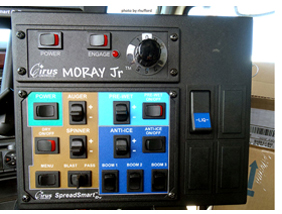

North-central region chosen as proving ground for ITD's award-winning
and money-saving winter road system
The Idaho Transportation Department's north-central region (District 2) contains 1,500 lane miles packed into a five-county area covering more than 13,000 square miles of diverse geography and rugged terrain. It represented the perfect proving ground to demonstrate the effectiveness of the department’s winter road-clearing system.
An article titled “Measuring Mobility: DOTs want to copy Idaho's system for measuring how changes to snow and ice control plans affect safety and mobility”, in the April edition of Public Works magazine, details how ITD empirically verified the effectiveness of its snow- and ice-control operations. Most of the information and many of the quotes that follow are from the magazine article.
Keeping Idaho’s 12,000-plus highway lane miles safe and clear each snow season, and ensuring the movement of interstate commerce, out-of-state visitors and Idaho’s 1.6 million-population, was the focus of the system improvements. The challenge was to prove effectiveness on “largely remote highways in a sparsely populated state with diverse terrain ranging from valleys and mountains to plains and highlands.” 
A spreader-control system from Cirus Controls identifies product used, application rate, speed of application, pre-wetting information and location. Pictured to right: ITD truck with Cirus operating equipment.
Reviewing snow- and ice-control treatment effectiveness along with timing, District 2 staff (located in the southern part of Idaho’s panhandle) realized they needed to modify some practices.
The electronic spreader-control system regulates the rate of salt and other deicing materials applied to road surfaces based on a snowplow truck’s speed, location and road-surface temperature. It provides accurate and reliable data on the amount and type of materials applied to road surfaces, enhanced with GPS location data and nearly real-time reporting.
“We then can compare this to input received via our RWIS (Roadway Weather Information System) monitoring sites to determine how successful our treatments were,” said ITD Winter Operations Coordinator Dennis Jensen. “If they do not meet the success criteria goals, adjustments then can be made in the timing and product rates.”
District 2 was the first of ITD’s six regional districts to have 100 percent Cirus controller deployment in their 10-wheel trucks — 51 tandem-axle snowplow trucks equipped with the new spreader-control system, plus one multi-purpose truck.
District staff evaluated data from both the new spreader-control system and from the RWIS monitoring sites and then compared effort with accomplishment. This winter season, the district made significant changes in product selection, timing and material application rates based primarily on data supplied by the spreader control and RWIS systems.
“I know the D2 foremen used both systems heavily this year and this year’s accomplishments are reflecting that,” said Jensen.
During the course of the testing, ITD also determined a $600,000 annual savings on winter-maintenance materials was possible once implemented statewide. Jensen said that based on projected return on investment, the new system would pay for itself in two to three years. A special appropriation was received to equip all ITD snowplows with the spreader-control system.
Each of the 125 RWIS sites statewide use sensors to measure air temperature, wind speed and direction, and precipitation. The sites also use pavement sensors, optical cameras and lasers to measure the thickness of individual layers of ice, snow or water on road surfaces.
To date, ITD has installed the new spreader-control system on 224 of its 450 snowplows. ITD anticipates having its entire fleet equipped within the next two years. Pictured to left is the controller-system panel.
“ITD’s approach resulted in a sophisticated, integrated and calibrated spreading and road clearing performance-measurement system,” the article stated.
“The RWIS technology has allowed us to compare events across the state and pinpoint storm event similarities,” added Jensen. “The integration of spreader controllers and GPS-based spreading data, along with RWIS data, gives ITD a window into our operations that didn’t exist before.”
ITD can now see exactly what treatment its snowplow trucks executed at RWIS locations and match that specific material-application data and timing to the RWIS road-surface data, before and after treatment, to evaluate the effectiveness of its winter road-maintenance operations.
“Bottom line,” said Jensen, “we can see how well we’re doing at preventing and removing ice from roadways.”
Jensen said ITD now has Cirus controllers fully deployed in District 1, District 2, District 3 (essentially the entire western part of the state from the Canadian border down to the Nevada border) and partially deployed in the other three districts.
The department defines its mobility index as the percentage of time a traveler’s mobility is not significantly impeded during winter storms. Just a few years ago, that rate was just 28 percent of the time. Thanks to the new system, now it is 71 percent, and growing.
ITD’s winter road-maintenance operations have received national and international notice in the past few years, as 14 states, two Canadian provinces, Sweden, Belgium and several universities have contacted the department about the award-winning system. The program also was presented in Tokyo, and at conferences in Ireland and Europe. Scotland is the latest – they implemented the system this winter.
Published 04-10-15